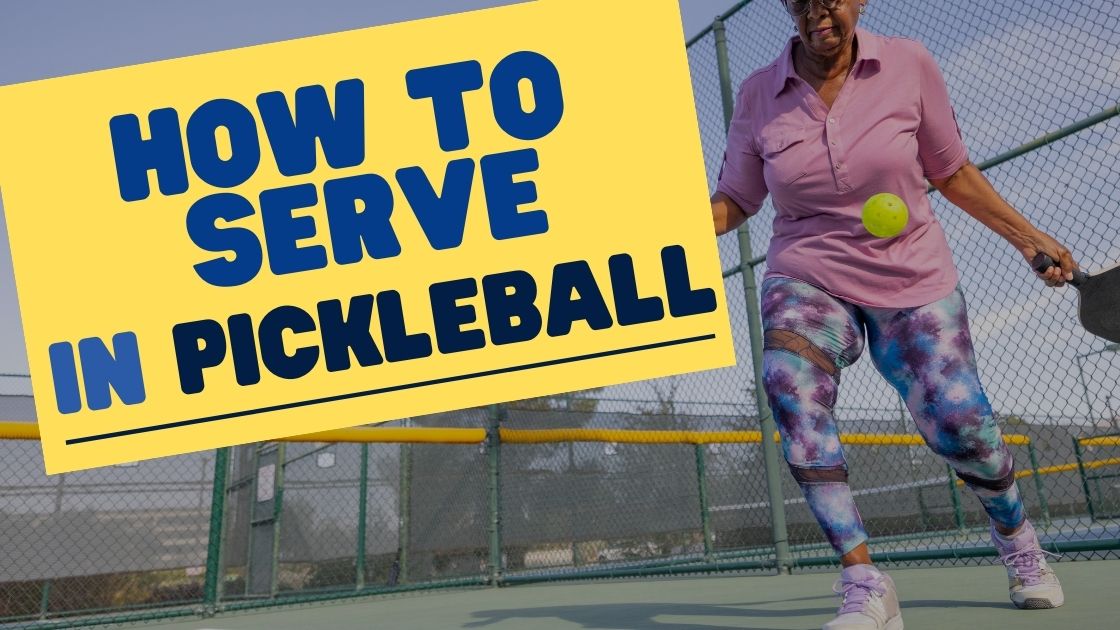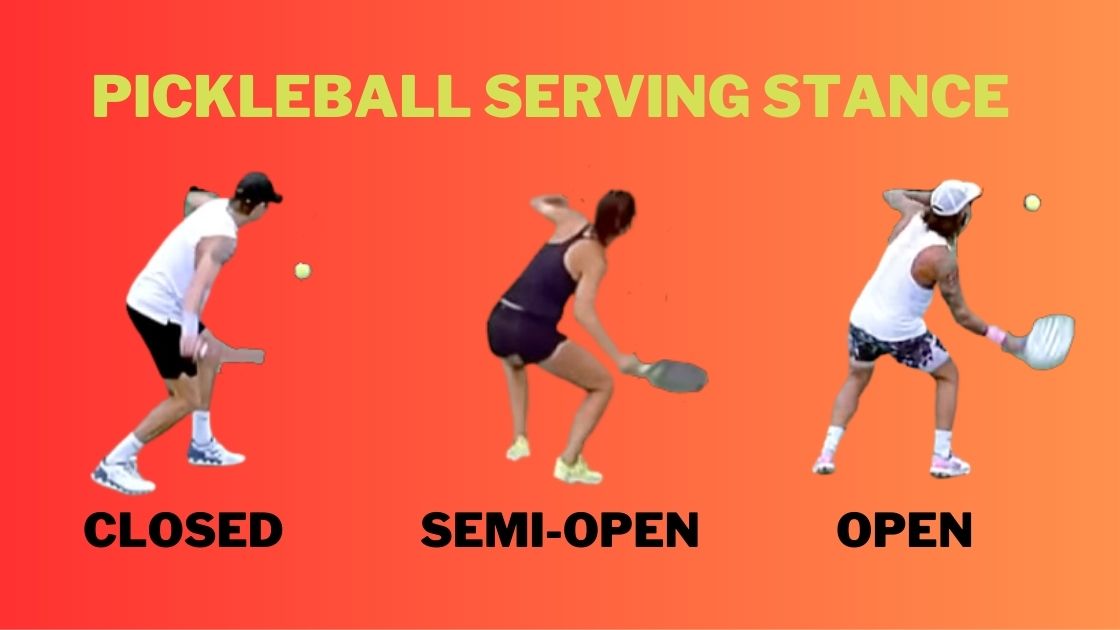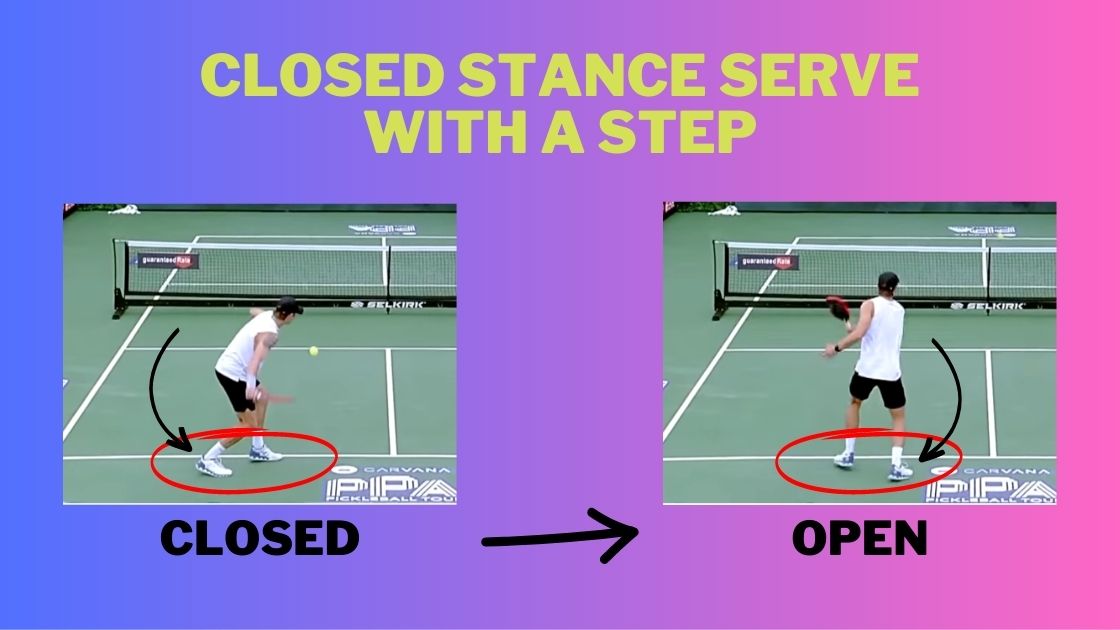
How to Serve in Pickleball
Having a good serve in pickleball is important for a number of reasons, the first of which is because the serve starts the point! You could make the argument that serving is more important in tennis vs pickleball because a weak serve in tennis can be attacked viciously by a good player. This is also true for pickleball, but a pickleball can only travel so fast and there are rules in place that prevent crazy amounts of spin.
In any case, it is extremely important to learn how to serve properly in pickleball. In this blog post we’ll go over how to serve from start to finish, how can you serve differently depending upon your skill level and common mistakes to avoid.
Table of Contents
- What is a Pickleball Serve
- Pickleball Serve Rules
- Pickleball Serve
- Advanced Pickleball Serve Techniques
- Conclusion
What is a Pickleball Serve
A pickleball serve is the first shot that starts the point. It is hit diagonally from behind the baseline, across the court and must land in the service area. The service area is the 15 foot by 10 foot box behind the non-volley zone, better known as the kitchen.
When serving, the player has a choice of hitting the ball out of the air by tossing it to themselves, or dropping the ball and letting it bounce before hitting. Either way is acceptable and comes down to personal preference. The majority of professionals do not use a drop serve.
The most important thing to remember when serving is that consistency and getting the ball in should be the top priority. Serving is just to start the point and it isn’t critical to have a very fast or heavy spin serve as a beginner. This will matter more as you play against better players, but for now just focus on getting the ball in the court.
Pickleball Serve Rules
Before jumping into how to serve in pickleball and basic serving technique, there are a few quick serving rules to go through.
- You must serve underhand, making contact below your belly button
- The paddle can’t be above your wrist on contact
- Both feed must be behind the baseline on contact with at least one foot on the ground
- The ball must land in the crosscourt service area and past the kitchen line
You can learn more about pickleball serving rules in this in depth blog post, but for now, these rules will get you started!
Pickleball Serve
The basic pickleball serve is best used for beginners and those that are still getting comfortable with a racquet or paddle sport. It can be learned in 3 simple and easy steps.
- Preparing Your Stance and Grip
- Tossing the Ball
- Hitting the Ball and Shifting Your Weight
Preparing Your Stance and Grip
The first step in the basic pickleball serve is finding a comfortable stance. There are three basic stances to chose from when serving. They are an open stance, a semi-open stance, and a closed stance. Open stance serves are typically used by more advanced players, but there are many professionals that serve with a closed or semi-open stance.

Part two of finding your stance is to decide if you’re going to serve with or without a step. Serving without taking a step with the front foot is common for advanced players, but many of them do rotate around with the back foot coming forward towards the end of the swing. Here is a picture of Pickleball pro Christian Alshon serving with a closed stance. He keeps the front foot planted and takes a step with the back foot as he rotates around during the serve.

Some beginners find that serving with a small step can help them get into a repeatable serving rhythm. For beginners, we’d recommend starting with a closed or semi-open stance and possibly with a small step forward if that is more comfortable. Again, this is a personal preference. Try not to get frustrated if a particular stance doesn’t feet right when you get started.
For right handed players, you’ll have your left foot forward and your right foot back with your front foot at a 45 degree angle pointing towards the right. Your feet do not need to be one foot in front of the other (closed stance) unless that is more comfortable. The knees should also be slightly bent. If you decide to serve with a step, think about it as if you were bowling. The last thing you do before rolling the ball down the lane is planting your front foot to shift your weight forward. A pickleball serve is no different.
Now that you’ve found a comfortable stance, it’s time to check your grip. Using the correct grip on the serve will make this shot a lot easier to master. Many beginners don’t have too much of an issue finding the right grip for them since they use the same grip as they typically would when hitting a forehand. A regular forehand grip, or eastern forehand grip, is the most preferred grip to use when serving.
Past tennis players who grew up using a continental grip, or shake hands grip, may find themselves gravitating back to this grip on the serve. If they’re comfortable with it and don’t have any issues, then theres little harm in using this grip as a beginner. For new players, using this grip will probably feel uncomfortable and make it difficult to be accurate on the serve.
Another serving grip that is common for new players is the frying pan grip. The thought process with this grip is that it is easy to hit the ball in a straight line and scooping the serve over the net. We’re not a huge fan of this grip as you’re limited in where you can hit the ball and how much spin you can use. It is also very easy to mishit the ball and lose your accuracy.
Tossing the Ball
Step number two in the pickleball serve is to toss the ball to yourself. If possible, you should try doing this without letting the ball bounce. For some players, this might be asking too much, but this is doable for almost everyone. New pickleball serving rules do allow you to let the ball bounce when you serve. If this is more comfortable for you as a beginner, you should let the ball bounce.
The ball toss for beginners should not go much above your head. You should try to release the ball from your hand when your hand is above your waist, at or around chest height. You want to lift your arm up as one unit and release the ball from your finger tips. This will help to give you a more consistence toss.
Try not to bend the arm or flick the wrist during your toss. Doing this can lead to an inconsistent toss and make serving more difficult than it needs to be. It will be much easier to learn the serve if you can toss the ball the same way every time.
Hitting the Ball and Shifting Your Weight
The last step in the serve is hitting the ball and shifting your weight. Getting into a good serving rhythm and staying on balance are some of our favorite pickleball tips that helps you have strong and consistent serve. If you serve with a different technique each time, you’ll struggle to find a comfortable and repeatable serve.
Shifting your weight can be done with or without a step. Serving with a step will make this part of the service motion more obvious since your body is moving forward as you take the step prior to hitting the ball. Serving without a step will involve some bodyweight transfer from hips, moving from the back leg to the front leg.
This part of the swing may take some time to get used to but do not over think it. You will naturally shift your body weight towards the ball as you hit it. What you want to avoid doing is standing still with your legs straight when serving. This is bad serving rhythm!
So far you’ve found the right stance, the right grip, the right toss, a good rhythm and now it’s time to hit the ball. The service motion should be low to high, similar to how you’d hit a ground stroke from the baseline. The swing path will start with the paddle below the waist with the tip of the paddle pointing somewhere near the ground.
Next you’ll continue the motion from low to high finishing around chest height. Start with a 50% swing speed and increase or decrease it from there. To get started, think about this like a pendulum with a consistent speed going back and forth.
Don’t forget that you’ll be aiming across the court into the service box and the ball must land past the kitchen line. The angle of the paddle should be open enough to give enough arc on the ball so that is lands in the service box past the kitchen. It’s also a good idea to make sure the face of the paddle is open towards the target. Many beginners with angle the paddle face to far in one direction and hit the ball out. Aim for the middle to start!
Advanced Pickleball Serve Techniques
The advanced pickleball serve has the same fundamentals as a basic pickleball serve, but with increased spin, speed, and accuracy. For more advanced players, it’s important to pick up the pace and keep your opponents from attacking the serve. In this section we’ll talk about three techniques you can use to bring your serve to the next level.
Serving Open Stance or Semi-Open
It’s not uncommon to see professional pickleball players serving with an open or semi-open stance. The main reason for this is that you can generate more power and paddle speed by rotating your hips during the swing. This can be thought of somewhat like a golf swing. If you stayed perfectly sideways during your golf swing and didn’t open your hips, you’d generate less club head speed on contact. The idea is the same with a pickleball serve.
Before moving on, it’s important to know that there are many professionals who serve with a closed stance. Their stance does not negatively impact the overall performance of their serve or cause them to lose more matches. It is simply personal preference to have an open or closed stance and any benefits at the professional level are marginal.
Serving With Topspin
The next technique to bring your serve to the next level is to hit with topspin. Topspin will allow you to hit the ball harder while keeping the ball in the court. If you’re an intermediate or advanced player you’ll already be familiar with hitting the ball with topspin.
Adding topspin to the serve will not only allow you to hit harder, but it will also help you improve your accuracy. Once you’ve gotten the hang for serving with topspin, you’ll notice that it becomes a repeatable process and you gain muscle memory. It is much easier to hit the same serve over and over again with topspin than it is when hitting the ball flat.
In order to generate topspin, you’ll want to increase paddle speed from low to high when making contact with the ball. This creates a brushing motion on the back of the ball that causes the forward rotation. You will want to be careful snapping your wrist too much when doing this as you could find yourself hitting an illegal serve. Remember, the paddle cannot be above your wrist when you make contact with the ball.
Keeping the Serve Deep
Serving with depth is another way to make your serve more difficult to return. If your opponent knows you can hit a deep serve, they’ll either need to stand further back on the return, or block the ball back in a defensive way. Either way, you’re applying more pressure on the returner and trying to get them to hit unforced errors.
You can increase the depth of your serve in two ways.
- Hitting the ball harder
- Hitting the ball with more arc
There should be a balance between hitting the ball harder and hitting the ball with more arc when trying to hit the ball deeper into the service box. You’re better off focusing on more arc, or hitting the ball higher, than hitting the ball harder. The harder you swing the more that can go wrong. A slight change in the angle of the paddle face can cause the ball to go out. Giving the ball more arc is a much safer way to add depth to the serve.
Conclusion
Serving in pickleball is not supposed to be difficult or complicated, and the rules in place are there to level the playing field. The most important thing to remember is that the serve is there to start the point. You don’t need to do anything special in order to have a good serve. Focus on staying loose, having a comfortable stance and a proper grip. Add in a little bit of practice and you’re well on your way to having a great pickleball serve!